Terror of Taraka
Every
cosmic event begins with the triumph of demons and ends with the triumph of
gods. Neither remains undefeated forever.
Prajapati
Kashyapa, patriarch of the celestial race fathered both the devas and the
asuras.
Kashyapa
made the devas, the gods of light. The asuras were to be the demons of
darkness. By granting them mutually antagonistic roles he ensured their eternal
enmity. The gods and demons stood on opposite poles of the cosmos. Everything
the gods did, the demons opposed. The gods fought for the day; the demons for
the night. The gods favored summer; the demons favored winter. The gods helped
the moon to wax; the demons caused it to wane. These eternal squabbles, these
cosmic wars, with alternating triumphs and tragedies, provided the dynamism on
which the cosmos sustained itself.
Often
the gods, strengthened by sacrifices and offerings, the yagnas, managed to
fight the demons on their own. But there were times when reinforcements had to
be called for. Such a time arose when Taraka became commander of the asuras.
The devas found it near impossible to defeat him. They went to Brahma for help.
"He
can only be killed by a seven day old child," revealed Brahma, creator of
life, master of destiny.
 "Where
will we find such a powerful infant capable of leading the gods?" they
asked.
"Where
will we find such a powerful infant capable of leading the gods?" they
asked.
"With
Shiva,' of course" replied Vishnu.
Shiva's Divine Spark
Shiva
and Parvati had isolated themselves in their cave, away from all interruptions.
Entry was forbidden even to the gods.
So
the devas stood outside and, in a very loud voice, began discussing the chaos
caused by the demons, especially Taraka. They began to howl and cry, lamenting
their inability to deal with this terrible situation. Disturbed by the din and
feeling sorry for the gods, the cosmic couple stepped out of their cave.
"How can I help you?" Shiva asked.
"Give
us a child capable of fighting demons on the seventh day of his life," the
gods begged.
Shiva
agreed. "Take the essence of my austerities. From it will rise my son, the
greatest warlord in the cosmos."
Shiva
cast his spiritual energies into a fire. But Agni, the fire-god, could not bear
its radiance for long. He cast it into the river Ganga, causing its cool waters
to boil. The terrible heat thus generated set fire to the reeds on the river
banks. In that great blaze, Shiva's energy transformed into a radiant child, a
boy with six heads and twelve arms.
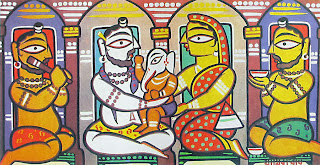 When
the fire died out, six wandering nymphs called the Krittikas, found the baby
beneath the embers and smoldering ash, within the petals of a splendid lotus.
They nursed him and took him to Shiva.
When
the fire died out, six wandering nymphs called the Krittikas, found the baby
beneath the embers and smoldering ash, within the petals of a splendid lotus.
They nursed him and took him to Shiva.
The
sight of this extraordinary child filled the gods with awe. He was given many
names in keeping with his status Skanda, the energetic emission; Mahasena, the
great leader; Guha, the mysterious one; Shanmukha, the six faced boy; Pavaki,
son of fire; Gangeya, son of Ganga; Sarabhu, born amidst reeds; Kumar, the boy
and Kartik, son of the Krittika maidens. Shiva gave him a powerful lance, vel,
as a weapon; a rooster for his insignia; a peacock for his vehicle, his vahana.
He became Velan, the lance-bearer.
On
the seventh day of his life the child let out a shrill war-cry and challenged
the demons to a fight. It was a splendid battle, one that shook the foundations
of the cosmos. Kartik killed not only the demon Taraka but also the demons
Banukopan, Soorpadam and Simukha. The gods rejoiced and thanked Shiva for his
son.
Birth of Ganapati
 Parvati
wanted a child, someone to keep her company when she was alone in Kailas, when
Shiva chose to meditate in isolation. Mount Kailas, without its lord, was a
desolate place: all snow and stones, filled with an oppressive silence.
Parvati
wanted a child, someone to keep her company when she was alone in Kailas, when
Shiva chose to meditate in isolation. Mount Kailas, without its lord, was a
desolate place: all snow and stones, filled with an oppressive silence.
Shiva
refused to be burdened with a family. In her loneliness, Parvati decided to
produce a child on her own. She was after all the mother-goddess!
The
next time Shiva disappeared into the deodar forest seeking a respite from
married life, Parvati went to lake Manasarovar. There she scrubbed her body
till it was red. She collected the dirt and dead skin, mixed it with sandal
paste and clay and molded out of it a doll, a cute little boy. Parvati fell in
love with her creation and quickly breathed life into it.
She
called him Vinayaka, the leader, and spent days talking and playing with him.
In his company she forgot all about Shiva. Days passed.
One
day, Parvati told Vinayaka, "I don't wish to be disturbed. Don't let
anyone into my cave."
"I
won't," he promised.
Sometime
later, having finished his long penance, Shiva returned to Kailas. He found
that the entrance to his cave Was blocked by a boy, one he had never seen
before.
"Stop!"
said the boy as Shiva approached the cave, "You cannot enter this
cave." Shiva ignored the boy and tried to walk past him. "Stop! I
say," the boy snarled, pointing his lance at Shiva, "One more step
and I will have to use force."
"Listen
boy, don't you know who I am?" said Shiva.
"No,
I don't. You may be Brahma himself, but I will not let you enter the
cave."
"How
dare you talk to me in that tone?" said Shiva, his temper rising,
"Step aside before I am forced to hit you." Shiva tried to push the
boy aside and enter the cave by force, only to have a lance pushed against his
throat.
Shiva
lost his temper. He raised his trident, the dreaded trishula and hurled it at
the boy. The sharp blades slit Vinayaka's neck. He dropped dead, blood gushing
out of his headless body.
Disturbed
by the commotion outside, Parvati rushed out of the cave. The sight of
Vinayaka's severed head and lifeless body horrified her.
She
fell to the ground, beating her breasts, shedding tears of blood. "My son,
my son," she cried clutching the mutilated head against her bosom.
Inconsolable, she pulled her hair and smeared her body with dirt.
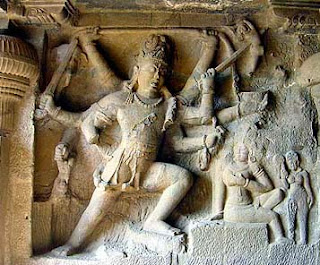 Shiva
realizing the seriousness of the situation, regretted his anger, his lack of
restraint. To make amends he decided to resurrect the boy. Otherwise, Parvati
would never forgive him.
Shiva
realizing the seriousness of the situation, regretted his anger, his lack of
restraint. To make amends he decided to resurrect the boy. Otherwise, Parvati
would never forgive him.
Shiva
told his ganas, "Get me the head of the first living creature you
encounter on leaving Kailas."
They
did as they were told. They came across a mighty one-tusked elephant and
brought its head to Shiva. Shiva placed it on the headless corpse and brought
the boy back to life.
Vinayaka,
with a body molded by Parvati and a head given by Shiva, came to be known as
Ganapati, leader of the ganas. He was given a mouse to serve as his mount. He
became guardian of the threshold, the cosmic doorkeeper.
He
is the remover of all obstacles, Vighneshvara. Without appeasing him with
prayers, no work can be done, no task can be completed, no project will be
successful. He keeps watch over every hurdle.
Andhaka, the Blind Son of Shiva
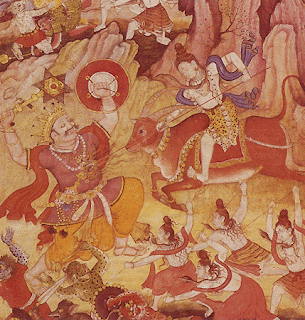 Once
Parvati covered Shiva's eyes in a spirit of play. Her hands started to
perspire, for Shiva's eyes contained the energy of the sun. From Shiva's heat
and Parvati's sweat arose an emaciated blind boy.
Once
Parvati covered Shiva's eyes in a spirit of play. Her hands started to
perspire, for Shiva's eyes contained the energy of the sun. From Shiva's heat
and Parvati's sweat arose an emaciated blind boy.
"He
is our son," said Shiva. Parvati nursed him until he had developed a
powerful sixth sense that made up for his blindness.
Shiva
gave his blind son to the demon-king Hiranyaksha, his beloved devotee, who had
no children of his own. Under Hiranyaksha's care, the child grew up to be a
powerful warrior, dreaded even by the gods. He was called Andhaka, the
blind-demon.
One
day, Andhaka heard of Parvati, the most beautiful woman on earth. The bards
described her beauty with so many superlatives that he decided to make her his
queen.
Andhaka
entered Kailas the moment he learnt that Shiva and his ganas had left for the
lake Manasarovar. Parvati was all alone.
On
seeing Andhaka, she sensed his unholy intentions. She could have easily
destroyed him but her maternal instincts overruled her sense of outrage.
She
prayed to Vishnu for help. The cosmic saviour heard her prayers and arrived on
Kailas in the form of a hundred thousand damsels, the Mohinis, each one more
ravishing than the other. Which one of them was Parvati wondered Andhaka.
Hours
went by. Andhaka wandered amongst the beautiful women, totally confused and
disoriented.
When
Shiva returned, he divined what was happening. Infuriated, he impaled Andhaka
with his trident; then, raising him up like a flag, he exposed the blind-demon
to the elements. There he remained for a hundred thousand years, paying the
price for his base intentions.
Andhaka
lost his divine sight. He became emaciated and weak, with just enough strength
to apologise to his mother and sing praises of his father.
Shiva,
who never bore a grudge for long, was moved by his son's repentance. "I
forgive you, Andhaka. You were born in darkness, hence you had a dark
personality. But now you are enlightened. You shall now live amongst my ganas,
taking your rightful place as my son."
Andhaka,
the demon of darkness, became an enlightened follower of Shiva. The lord's
grace removed the shadow of lust that had muddled his good sense.
Ganapati's Marriage
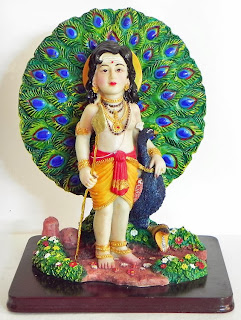 Parvati
could not decide which one of her sons should be married off first: Kartik or
Ganesha. Shiva proposed a competition. "Let us celebrate the marriage of
the one who returns first after going all round the world," he said.
Parvati
could not decide which one of her sons should be married off first: Kartik or
Ganesha. Shiva proposed a competition. "Let us celebrate the marriage of
the one who returns first after going all round the world," he said.
As
soon as the race was announced, Kartik leapt on his peacock and rushed off to
circumambulate the cosmos. It was a long journey, but Kartik's determination
saw him through.
Ganesha
did not bother to move from his seat. When he saw Kartik returning to Kailas he
quickly went around his parents.
"I
won," declared Kartik.
"No,
I did. I went round the world before you did," said Ganesha.
"What
do you mean: you went round? You did not take a step out of Kailas! It was I
who went round the world on my peacock."
"You
went around your world the great cosmos. I went around my world my parents.
Since I finished first, I have won."
Parvati
said, "You both have won in your own way: Kartik is the victor in a
tangible sense. But in a more subtle, a more intellectual sense, Ganesha
emerges as the victor."
Parvati
was proud of her sons, the strong Kartik and the wise Ganesha. She declared,
"He who worships Kartik will gain strength; he who worships Ganesha will
gain wisdom. You two are the two aspects of my power, shakti."
But
in the matter of marriage, Shiva decided that Ganesha should get married first.
"I think his wit deserves to be rewarded."
Kartik
was furious.
Kartik Leaves Kailas
Shiva
let Ganesha marry first despite Kartik's valid arguments and opposition. The
two daughters of the prajapati Vishvaroopa, Siddhi and Buddhi, goddesses of
success and intelligence, became Ganesha's consorts, reinforcing his position
as lord of wit, wisdom and victory.
The
event upset Kartik terribly. He felt that his parents did not value him, his
qualities or his feelings. But few were willing to listen to him. Everybody was
enjoying themselves at Ganesha’s wedding.
Kartik
became convinced that he was not wanted. So he left Kailas and moved
southwards. When the Krauncha hills tried to block his path, he simply hurled
his lance and carved a path right through them.
Shiva
tried to make peace with his son but Kartik refused to see him, or speak to
him. He just wanted to be left alone.
Kartik's Marriage
Upset
by his parent's apparent favoritism, Kartik moved to the southern hills and
lived amongst the tribes there. The locals called him Murugan, the divine
youth. He protected them from demons and monsters that plagued the valleys and
forest paths. But all the while he remained lonely and miserable.
Indra,
king of the devas, saw the plight of this great warlord. He decided to give him
a wife, his own daughter Devayani, also known as Sena. It was the least he
could do for his mighty champion. They were married in the presence of the gods
according to priestly rites.
Sometime
later Kartik, while wandering in the dense jungles of the Tamil lands, came
across Valli, a beautiful tribal girl. She stood in the middle of her father's
millet field shooing away birds and beasts. Smitten by her beauty, Kartik asked
for her hand in marriage. Valli agreed and the two got married by natural
rites, inspired by love and in the presence of the elements.
Agastya Moves South
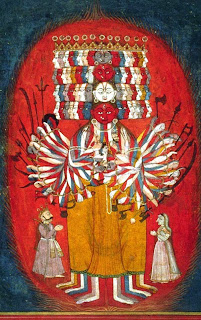 Shiva
once gave a discourse on yoga. Every creature in the cosmos gods, demons,
sages, sorcerers, kings, merchants, priests, slaves rushed to Kailas to hear
him speak. As a result of this mass exodus to the northern mountains, the world
started to tilt on one side.
Shiva
once gave a discourse on yoga. Every creature in the cosmos gods, demons,
sages, sorcerers, kings, merchants, priests, slaves rushed to Kailas to hear
him speak. As a result of this mass exodus to the northern mountains, the world
started to tilt on one side.
"Wisdom,
civilization, knowledge, skill, all this has come north; there is nothing left
in the south. The balance of the cosmos is totally lost," exclaimed
Brahma.
Shiva
realised the seriousness of the situation. He turned to Agastya, his wisest
disciple and said, "Go to the south. Take with you all that I have taught
you: the skill of communication, the secrets of astronomy and medicine; the art
of theatre and music; the science of agriculture and animal herding; the
fundamentals of philosophy; the knowledge of warfare; sacred lore; the
essentials of sacrifice. Take it all. Help the cosmos regain its balance."
"As
you wish," said Agastya, "But give me something that will remind me
of the Kailas hills." Shiva gave him two great hills to carry to the
south. The demon Ettumba offered to carry them on a ‘kavadi : he tied each of
the hills to the ends of a strong pole which he slung over his shoulder and
moved to the south.
At
Palani, in Tamil Nadu, Ettumba placed the hills on the ground and went to a
river nearby to refresh himself. When he returned he found that he could not
pick up the hills again. It was as if someone was holding them back.
He
looked around and found a beautiful young boy seated on one of the hills.
"Get off the hill, boy," growled Ettumba. But the boy refused.
"If you don't, I'll hit you." The boy still refused to budge. Ettumba
lost his temper and raised his arm to strike the boy, only to be kicked into
submission.
When
Agastya arrived on the scene, he instantly knew that this was no ordinary
child. "Who are you?" he asked. "I am Kartik, son of
Shiva," replied the boy. "These hills remind me of Kailas, my home in
the north that I abandoned long ago. I would like to stay here." Agastya
let him.
Since
then Kartik is said to reside atop the hills of Palani while Agastya resides on
the plains. With the two representatives of Shiva in the south, there was no
need for anybody to travel all the way to Kailas in the north. The balance of
the cosmos was restored. It is said, each year Shiva and Parvati visit their
son at his abode in the south, having reconciled their differences.
Celibate Sons of Shiva
There
is considerable confusion about the marriage of Ganesha and Kartik in
Jambudvipa, the rose-apple continent of India.
In
the north, Kartik is considered to be the elder son of Shiva and Parvati, born
before Ganesha. In the south,
Ganesha
is described as the elder brother; Kartik is the younger one.
In
the north, Kartik is said to be unmarried because he saw his mother in all
women. In the south, it is Ganesha who is believed to be the Brahmachari, the
son who didn't marry because he found no woman as wonderful as his mother.
In
North India, Kartik is described as a celibate warlord, the passionate
commander of the gods who cheers men into battle and leads them to a glorious
death. In some places where this quality is admired, women worship Kartik,
seeking a virile husband like him. But in most places his warlike spirit is
frowned upon and women, except a few widows, don't dare worship him. To them he
is the god of men, lord of their martial brotherhood.
In
the south, flanked by his two wives, Kartik is always seen as the
personification of virility and valor. His beauty is legendary. His wives, Sena
and Valli, symbolize his army and his weapons. His two marriages thus reinforce
his position as the champion of the gods, the god of brawn, the mighty-god.
In
the north, Siddhi and Buddhi are the consorts of Ganesha. They are the
goddesses of accomplishment and intelligence. This significant alliance makes
Ganesha the god of brains, the wise-god.
The
two sons of Shiva and Parvati represent two aspects of power, shakti. Perhaps
neither is superior nor elder to the other, for no man can be truly powerful
unless he has a well balanced measure of strength and wisdom.
Writer Name:- Devdutt Pattanaik
 When
the fire died out, six wandering nymphs called the Krittikas, found the baby
beneath the embers and smoldering ash, within the petals of a splendid lotus.
They nursed him and took him to Shiva.
When
the fire died out, six wandering nymphs called the Krittikas, found the baby
beneath the embers and smoldering ash, within the petals of a splendid lotus.
They nursed him and took him to Shiva.  Parvati
wanted a child, someone to keep her company when she was alone in Kailas, when
Shiva chose to meditate in isolation. Mount Kailas, without its lord, was a
desolate place: all snow and stones, filled with an oppressive silence.
Parvati
wanted a child, someone to keep her company when she was alone in Kailas, when
Shiva chose to meditate in isolation. Mount Kailas, without its lord, was a
desolate place: all snow and stones, filled with an oppressive silence.  Shiva
realizing the seriousness of the situation, regretted his anger, his lack of
restraint. To make amends he decided to resurrect the boy. Otherwise, Parvati
would never forgive him.
Shiva
realizing the seriousness of the situation, regretted his anger, his lack of
restraint. To make amends he decided to resurrect the boy. Otherwise, Parvati
would never forgive him.  Once
Parvati covered Shiva's eyes in a spirit of play. Her hands started to
perspire, for Shiva's eyes contained the energy of the sun. From Shiva's heat
and Parvati's sweat arose an emaciated blind boy.
Once
Parvati covered Shiva's eyes in a spirit of play. Her hands started to
perspire, for Shiva's eyes contained the energy of the sun. From Shiva's heat
and Parvati's sweat arose an emaciated blind boy.  Parvati
could not decide which one of her sons should be married off first: Kartik or
Ganesha. Shiva proposed a competition. "Let us celebrate the marriage of
the one who returns first after going all round the world," he said.
Parvati
could not decide which one of her sons should be married off first: Kartik or
Ganesha. Shiva proposed a competition. "Let us celebrate the marriage of
the one who returns first after going all round the world," he said.  Shiva
once gave a discourse on yoga. Every creature in the cosmos gods, demons,
sages, sorcerers, kings, merchants, priests, slaves rushed to Kailas to hear
him speak. As a result of this mass exodus to the northern mountains, the world
started to tilt on one side.
Shiva
once gave a discourse on yoga. Every creature in the cosmos gods, demons,
sages, sorcerers, kings, merchants, priests, slaves rushed to Kailas to hear
him speak. As a result of this mass exodus to the northern mountains, the world
started to tilt on one side. 



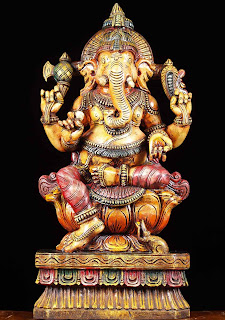

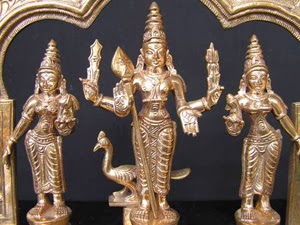

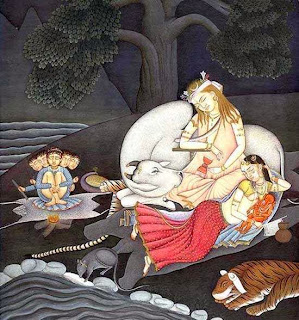










0 Response to "Sons of Shiva "
Post a Comment